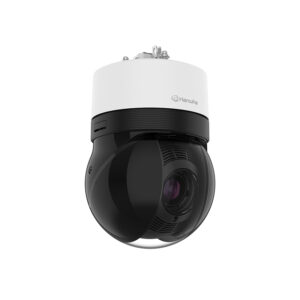 The XNP-C9310R is a 4K, 31x zoom IP67, IK10, & NEMA4X rated PTZ network dome. It has high sensitivity and long-range infrared support for day / night performance, with advanced AI management and subject detection capabilities.
The XNP-C9310R is a 4K, 31x zoom IP67, IK10, & NEMA4X rated PTZ network dome. It has high sensitivity and long-range infrared support for day / night performance, with advanced AI management and subject detection capabilities.
Getting started
The camera is not supplied with a mounting bracket so this must be purchased separately. A range including Hanging, Ceiling, Wall, Pole, Parapet and Corner mounts are available. The dome’s mounting arrangement uses a sprung three point insert and rotate style of fixing with a safety loop attachment point. Three M6 securing holes with 64mm (2.5”) centres in the top can be used for temporary fixings for workshop setup and configuration if required.
The only connection to the dome is its RJ45 HPoE port and this has a protective grommet and securing clip to hold it in place.
The supplied HPoE injector can supply up to 83W and supports up to 1Gb/s data. An SFP fibre data port socket is included for fibre network use. The supplied lead was a Euro style to C13 connector so a UK mains plug or lead change may be required.
The camera is given an operating temperature range of -55°C to +55°C and has dimensions of 296(h) x 188(Ø) mm without mounting bracket.
Operation
The dome has DHCP set by default or will use 192.168.1.100. It can be discovered using conventional network tools or the Hanwha Wisenet Device Manager software which can be downloaded from the website.
At first connection, a strong device password must be set. This requires the use of three-character types if the minimum 8- or 9-character password is used, or two character types if 10 or more characters. A hard reset button is available should the password be lost; this is located behind the micro-SD card slot cover on the rotating section of the body and accessible by releasing a captive Torx screw. Two card slots are available, each with an apparent capacity of up to 512GB.
The power demand is quoted as 23W typical with 62W maximum. In practice the quiescent demand was just under 20W, and around 40W with heater on and IR at maximum. Motor control and image processing appeared to add an additional 10W of momentary demand.
Camera movement is generally very quiet with a short burst of noise when travelling to presets at up to 550°/s. Manual pan and tilt is from 0.024°/s to 200°/s with a tilt range of 110°. Preset accuracy is very precise, given as ±0.07°. Up to 300 presets can be allocated, along with preset sequences consisting of Swing, Group, Trace, Tour, Auto Run, and Scheduled.
The motorised varifocal lens has a range of 6.91 – 214.7mm giving a horizontal angle of view from 60.6° to 2.59°, with an aperture from F1.36 (Wide) to F4.6 (Tele).
ONVIF, SUNAPI, and Wisenet open platform protocols are all supported.
Sound is not supported on the camera but is available through an optional network connected box.
Read the full review in the June 2024 edition of PSi magazine

